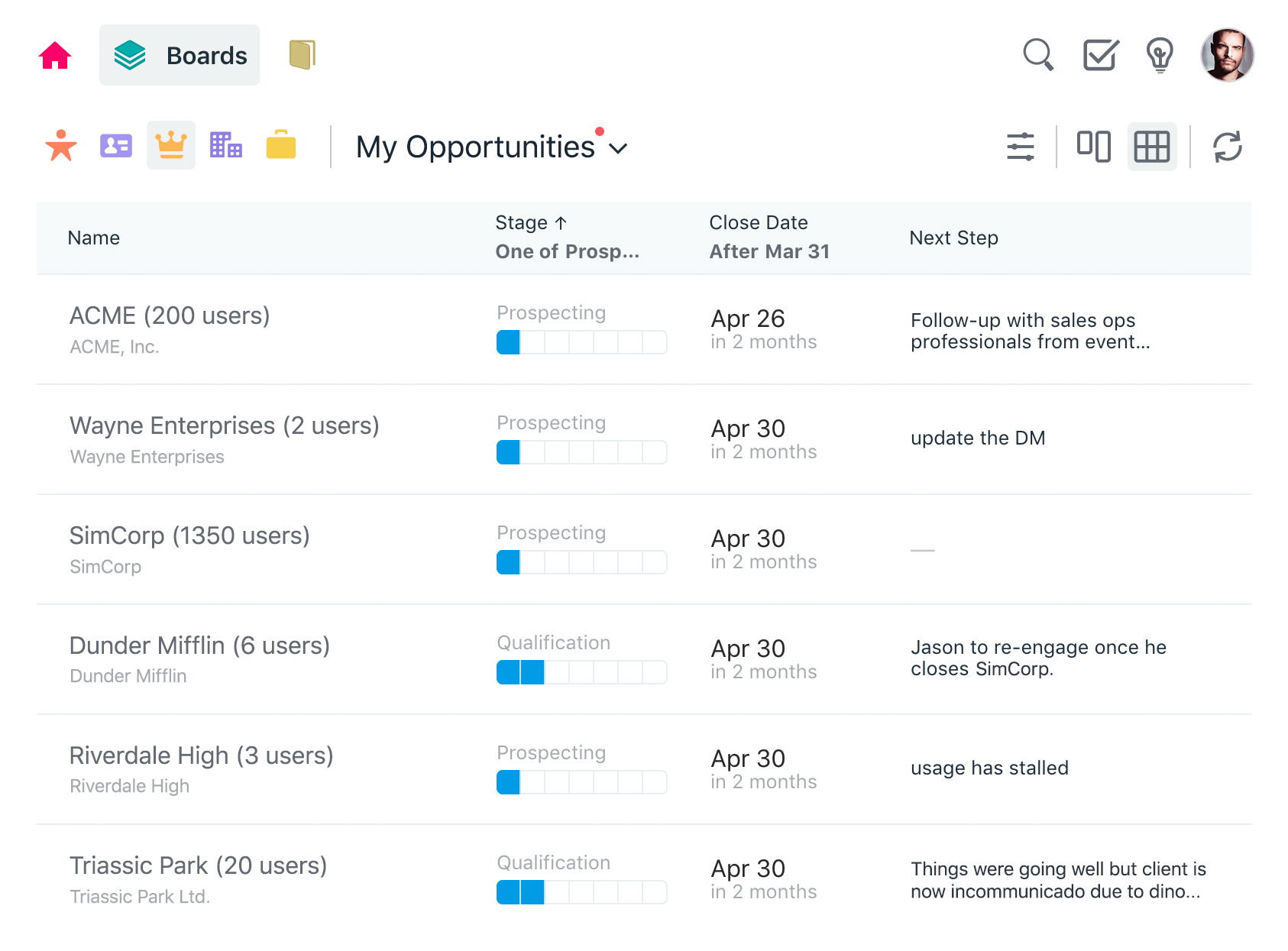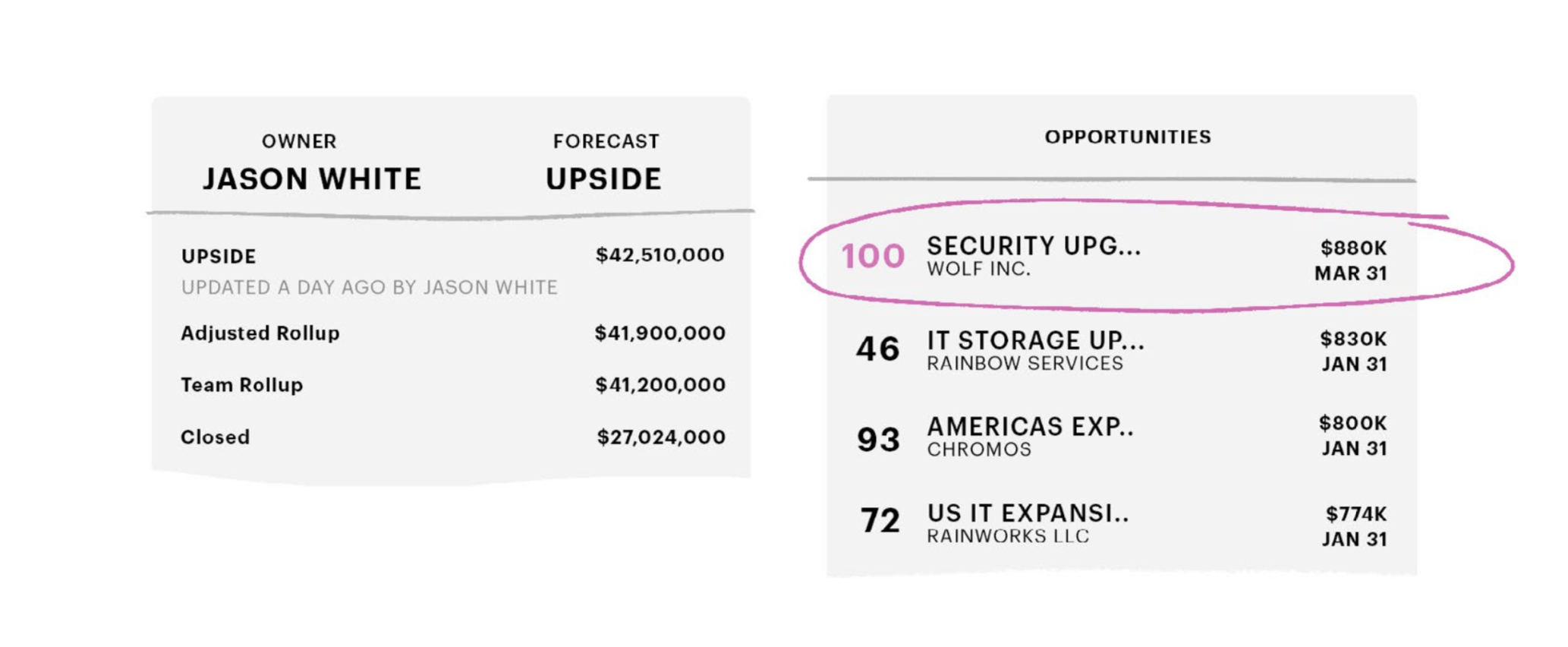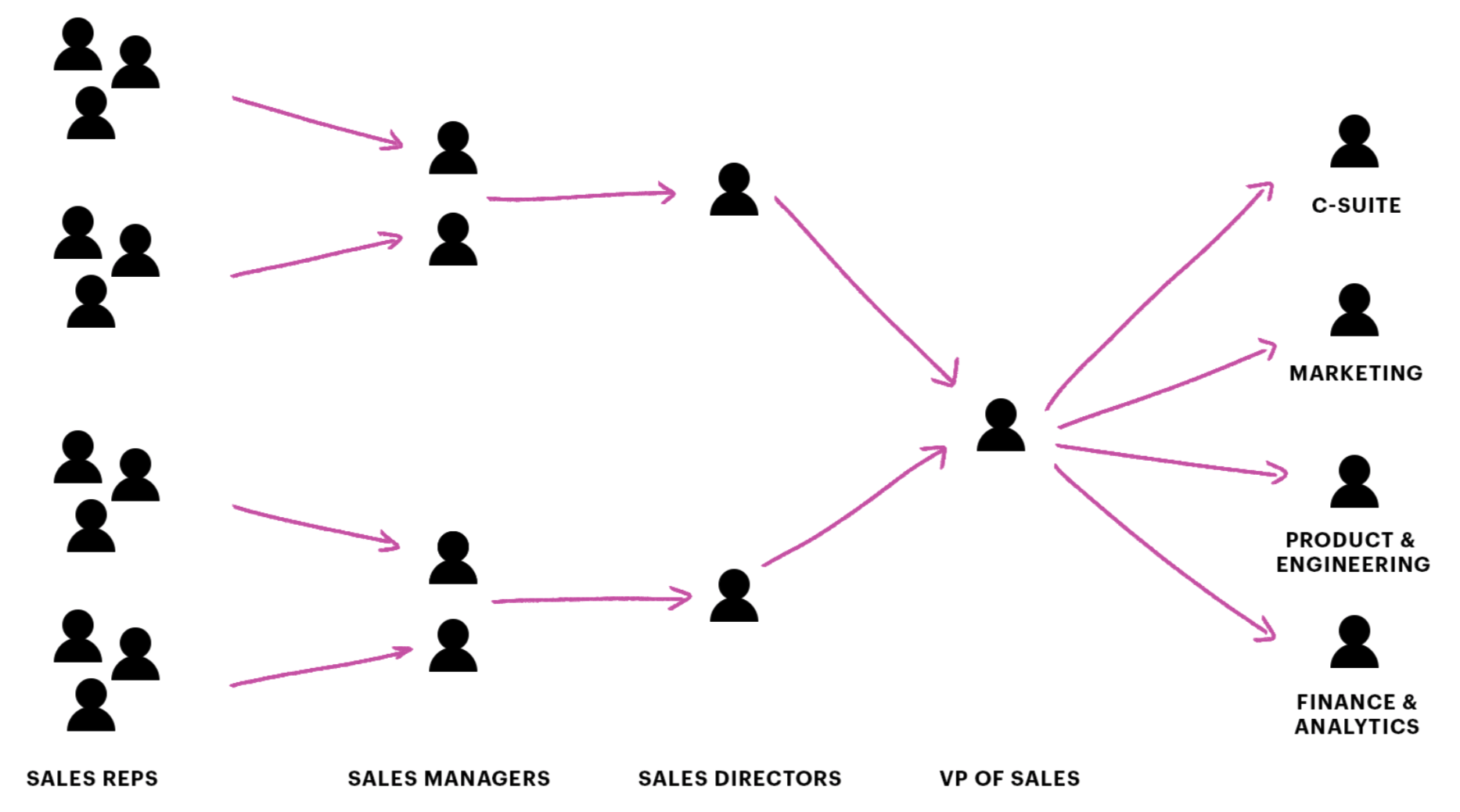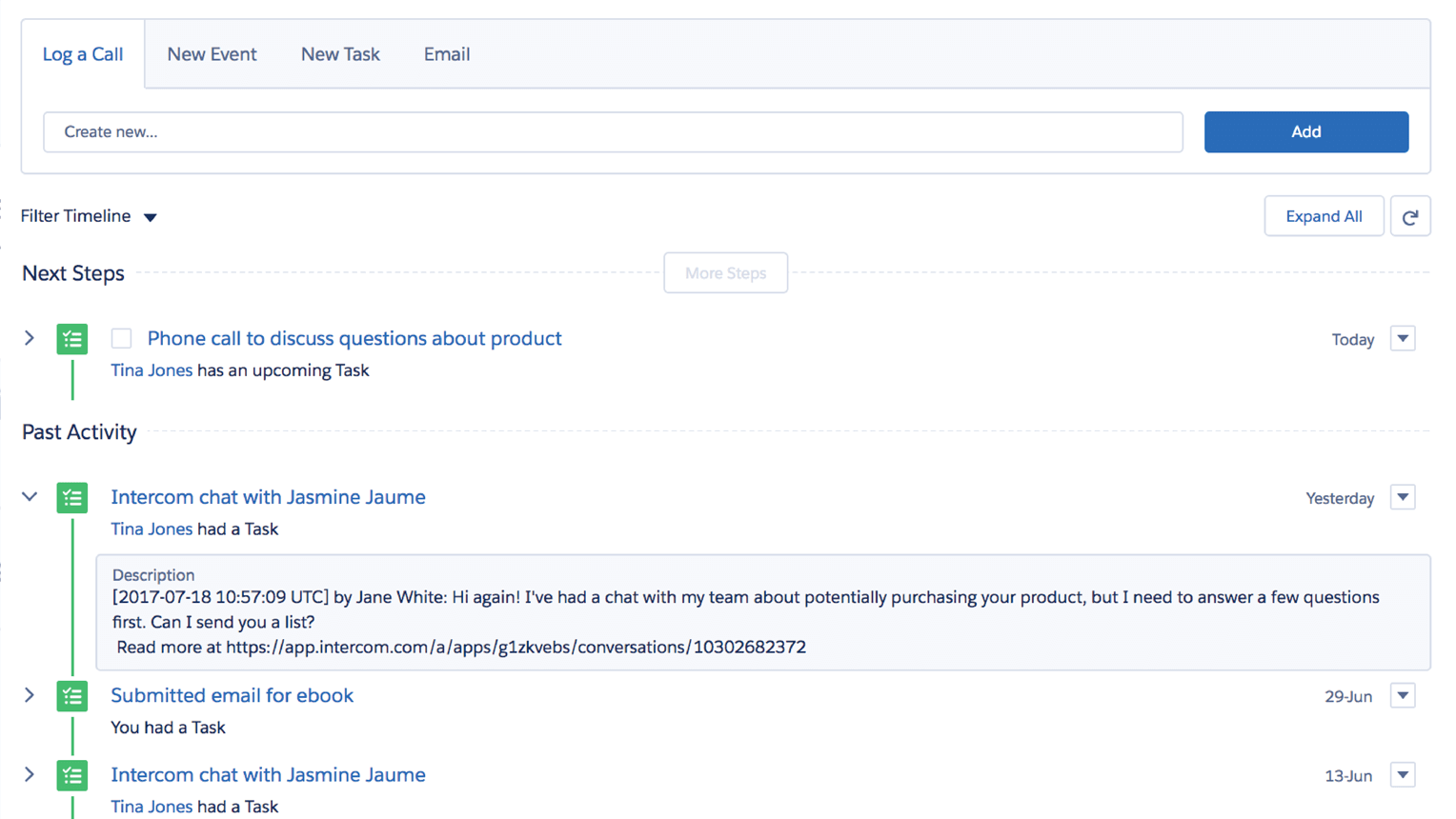
Eyes on the future: How to predict your revenue with sales forecasting
Main illustration: Tyler Gross
We all know it’s impossible for a sales team to predict future sales perfectly. But with rigorous sales forecasting, they can actually get pretty close.
Sales forecasting allows you to not only project how much revenue your team will close but also proactively influence current and future deals – by getting ahead of potential blockers, course correcting when you’re trending off target, moving into emerging markets, and more.
But forecasting isn’t as easy as asking your sales reps to give you a number. An accurate, actionable sales forecast requires a lot of work, cooperation from all parts of your sales team and visibility into your sales pipeline.
What is a sales forecast?
A sales forecast is a projection of future revenue within a specific period of time – typically, a month or a quarter. The forecast is usually based on data like the number of deals currently in your sales pipeline and what stages of the sales cycle they’re in.
Sales forecasting has many major benefits. Here are just a few based on our own experience:
- It allows our sales team to predict with a fair degree of accuracy which deals will close, and how much revenue will flow into the business as a result.
- It gives us time to change our sales strategy if we’re trending below target, so we can manage our revenue expectations for the forecasted period.
- It provides individual sales reps with visibility into their ongoing deals, allowing them to get ahead of potential blockers and course-correct as needed.
- It enables our entire organization to plan ahead, looking toward new uses cases or even emerging markets where there are opportunities for expansion.
How sales forecasting influences growth
Just knowing which deals are expected to close and how much money the business stands to make as a result doesn’t guarantee we’ll actually increase our revenue. In other words, sales forecasting itself doesn’t drive growth.
Instead, sales forecasting requires clear line of sight into our sales pipeline – what deals are in progress, the stages they’re at and the likelihood that they’ll close. That line of sight is what allows our sales reps and managers to proactively influence individual sales quotas and the organization’s overall revenue trajectory.
Here are three knock-on effects from forecasting that help drive growth:
1. Identifying deals that need immediate action
If a decision maker has been “trying to get budget approval” for several weeks, that’s probably a sign they’re not going to close anytime soon. Sales forecasting helps us address situations like this by requiring sales reps to regularly examine their pipeline and take action long before deals are at risk.
“Forecasting requires sales reps to examine their pipeline and take action long before deals are at risk”
By acting quickly, we can prevent “pipeline bloat” – when a sales pipeline is artificially inflated by deals that will never close. And if a deal does end up stalling, having a rigorous process in place means we’ll remove them from our forecast before we end up with inaccurate revenue projections.
2. Spotting sales tactics that are and aren’t working
Good sales forecasting requires active pipeline management. By keeping a close eye on our entire pipeline, we can identify useful correlations between our reps’ actions and deal outcomes. This allows us to double down on effective sales tactics and eliminate the ones that aren’t working from our sales process.
Here’s an example from our relationship management team: when we first created the team, we hypothesized they would primarily use email to drive customer retention and expansion. But when we examined their book of accounts, we were proven wrong. Instead we identified a strong correlation between customer calls and account growth. Without this analysis, we could easily have kept creating email campaigns with little to show for it.
3. Establishing the impact of new processes and tools
In sales operations, we’re constantly trying to optimize how our sales reps work, with the goal of enabling them to close more deals faster. Oftentimes, that means making process improvements or buying new sales tools. With sales forecasting, we’re well positioned to track the impact of these major changes on our pipeline.
This is exactly what we did when we rolled out Dooly, our sales enablement tool. We’re always aware of the risk of slowing down reps by adding another step to the sales process. But when we looked at how our reps were spending their time, it was clear that Dooly was helping our team work faster – saving them, on average, at least three hours per rep per week. Less time spent on administrative tasks means more time actually closing deals.

Here’s an example Board from Dooly, a tool we use to track conversations with our prospects.
So, how do you actually build a sales forecast?
There are a number of different ways to forecast sales. You can forecast using historical sales data, weighing deals in your pipeline by opportunity stage or scoring your leads based on behavior. The right method will depend on your team’s particular sales motion.
At Intercom we practice “category forecasting,” which combines insight from the sales rep and clear indicators from the account. I’ve boiled down our process to two repeatable steps.
Step one: Assign a status to every deal
The first step is having each sales rep assign a status to all their active deals. These statuses reflect how likely it is that a particular deal will close within the forecasted period – in our case, weekly.
These are the labels that we use:
- Firm: We expect to win these deals in the current forecast period. Our decision makers haven’t signed on the dotted line yet, but there are no major blockers we can see that will prevent us from winning the deal. We may be in the process of getting legal sign-off or finishing a security review.
- Upside: We have a chance at winning these deals within the forecast period, but there are still obstacles that need to be overcome. For instance, we may not have buy-in from the budget owner or have just started the procurement process.
- Pipeline: These are deals with the potential to be won in the forecast period but are unlikely to cross the finish line in time. This may be due to significant obstacles, like having to replace an existing vendor, or these deals may simply be new.

Every sales rep in a closing role provides a forecast for each status – firm, upside, pipeline.
Step two: Create your rollup forecast
The second step is creating your rollup forecast. We do ours every week, but if your sales organization is still growing, you might do it bi-weekly or monthly.
Here’s how we handle it: sales reps provide their managers with a forecast, which sales managers summarize for sales directors. Directors then provide a forecast based on trends and projections, plus the status of key deals and actions to be taken. Finally, our sales leaders use the forecast to set revenue expectations with the C-suite and our go-to-market partners.
 Having a weekly rollup forecast drives accountability throughout our entire sales organization, starting from the bottom up. It holds every person responsible for delivering revenue to the business.
Having a weekly rollup forecast drives accountability throughout our entire sales organization, starting from the bottom up. It holds every person responsible for delivering revenue to the business.
Avoid these common forecasting mistakes
You don’t need to have a lot of deals to start forecasting. But you do need proper sales pipeline hygiene – clear milestones that support your hypothesis about how likely it is that a deal will close. When sales organizations lack this hygiene, they usually make these mistakes:
- Unrealistic closing dates: Without clear milestones, sales reps have to guess when a deal will close based on they’ve been told. They don’t have any indicators to determine if “I’ll have approval in a week” actually means “I’ll have approval in a month… or two.”
- Overly optimistic forecasting: Similarly, a lack of visibility into the sales process can result in overly optimistic forecasts. A sales rep may be convinced that an account is going to buy your product’s premium plan, only to be surprised when they hear “We’ll stick with the free version” a few days later.
- Bloated sales pipeline: As I mentioned earlier, one of the big risks with poor pipeline management is “pipeline bloat” – when your forecast is stacked with deals that will never close. A messy sales process can make it hard for sales reps to tell the difference between a promising deal and a stalled one.
4 ways to improve your sales forecast
There are a few simple, yet crucial, ways you can make your forecasting process even more accurate. Here are four we recommend that any high-growth sales organization consider:
1. Experiment with different types of forecasting
While we prefer category forecasting, it’s not the only option. If you’re looking to update your sales forecasting methods, there are a few other methods you might consider.
- Historical forecasting: With this method, you use your past performance to predict your future performance. It’s the top-down approach to forecasting where you assume that under the same conditions, you’ll sell the same amount. If you have a steady growth rate, you’ll end up with a linear revenue projection that’s growing. This model works best for companies with highly transactional sales.
- Opportunity stage forecasting: This forecasting method requires having clearly defined sales stages. Leads are put into stages like “discovery,” “demo,” “negotiation” and so on. Reps then use these stages to determine how likely it is a deal will close. For example, you might determine that if a prospect schedules a demo, there’s a 15% chance the deal will close. This typically works well for sales team who sell to SMBs with predictable sales cycles.
- Pipeline forecasting: This method leverages specific data about your accounts to determine how likely it is deals will close. For example, if companies in the healthcare industry with 100-500 employees take six weeks, on average, to close, you’d apply that same logic to similar companies currently in your pipeline. This type of forecasting works best at sales organizations with lots of data to reference.
2. Continuously qualify sales opportunities
Not everyone who comes into your pipeline will be a good fit for your business. As you’re evaluating leads, be sure they meet the profile of your ideal customer. Without continuous lead qualification, you might end up chasing accounts that won’t close, ultimately wasting time and energy.
For example, for leads in a free trial, leveraging their customer data in Intercom helps our sales reps make informed predictions about who will or will not become a paying customer. We pay attention to key milestones like installing the Messenger or setting up their first chatbot. Frequent usage is a good sign that the prospect will end up converting, while inactivity is one sure sign they won’t.

We proactively message prospects during their free trial, so we can continuously qualify them and improve our conversion rates.
3. Identify opportunities for sales coaching
At Intercom we believe every sales manager should also be a sales coach, committed to enabling their reps and their team to drive to the right outcomes. That includes helping sales reps understand how to assess and manage their pipeline – things like how qualified prospects are, how likely deals are to close and when they’ll close.
By coaching our individual sales reps to better performance, our entire sales organization benefits. Our sales forecasts are more accurate, our reps are more likely to hit their quota and as a result, our combined revenue impact on the business is greater.
4. Create deep integrations between your sales tools
Finally, aim to integrate all your sales tools. An integrated tech stack leads to more accurate forecasts by ensuring your data flows seamlessly from one tool to the other. Manually copy-pasting information between tools isn’t just the bane of every sales rep’s existence. It’s also the fastest way to end up with bad data and an unwanted surprise at the end of the quarter.
Here’s a simple example: using your CRM as a source of truth. Since we rely so heavily on customer data in Intercom, it’s critical the data in Intercom and Salesforce, our CRM, is always in sync. Our app integration allows our sales reps to create Salesforce profiles for new leads, right from their inbox. And when it comes to creating their weekly forecast, they have all the information they need to make an informed call about how soon a deal will close.

Our integration with Salesforce makes it easy for our reps to get a complete view of deal progress.
Grow your business with accurate sales forecasting
Whatever size your business is, accurate sales forecasting gives you the power to project future revenue and grow it too. Combined with rigorous pipeline management, forecasting enables your team take swift action on their deals, invest in the right sales tactics (and do away with the wrong ones), and capitalize on new opportunities for expansion. Implemented correctly, sales forecasting is the backbone of consistent revenue growth.






